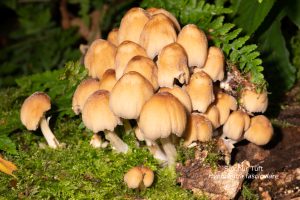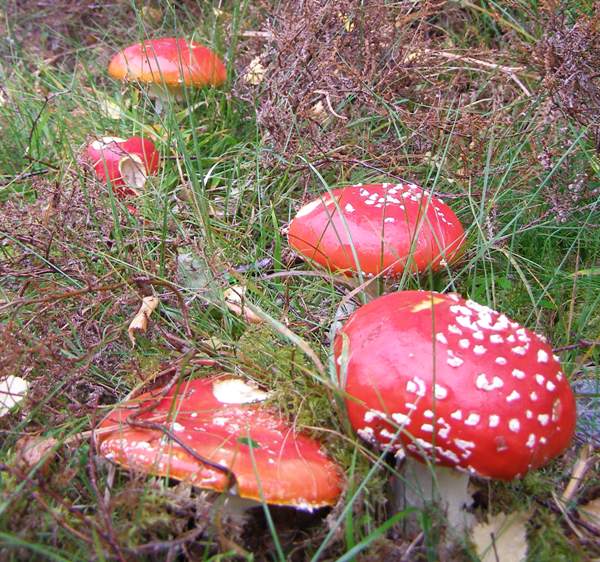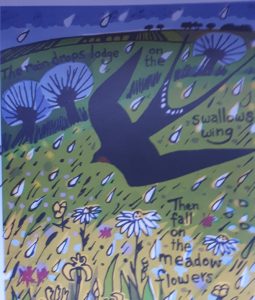Norley was once covered in Forest, its very name means a clearing north to the once mighty Forest of Mara. It still is heavily wooded in places and some Oak trees are many hundreds of years old, each one containing an amazing ecosystem of fungi and myriads of arthropods / insects supporting birds feeding and nesting there. The Holly and the Ivy provide nectar and pollen for may insects including the Small blue whilst its caterpillars feed on the plants. Orange tip caterpillars feed on Hedge garlic which grows abundantly in some hedgerows.
There are no traditional wildflower meadows but NWG has sown a variety of wild flower mixtures at the Memorial garden and around the Plaques of the Memorial walk. By mowing the Norley sign and just removing the mowings there was a subsequent magnificent flowering of Ladies Smock aka Cuckoo flower or in Cheshire, Milkmaids.
NWG, following a successful campaign in 2017, planted and distributed over 10000 snow drop bulbs. In 2019 CWT gave NWG the money for helping to sustain the dwindling Native Bluebells in the Wildwood next to St John’s. Over 1000 bulbs were planted and with thinning the trees to let more light in this has proved to be a success.
The raindrops lodge on the swallow’s wing
Then fall on the meadow flowers
Cowslips and enemonies all come with spring
Beaded with first showers
The skylarks in the cowslips sing
I love wild flowers
Blue bells and orchids in the wood
And pasture orchids too
Red yellow white and blue
Growing where the herd cows meet the showers
And lick the morning dew
I love wildflowers
Reproduced from the lovely book by the painter and printmaker Carry Ackroyd
Nature’s powers and spells Landscape Change, John Clare And Me.
Many people, as did John Clare, love wildflowers, NWG does but not only for their intrinsic beauty as they also provide the bedrock of complex ecological webs – bio diversity is the name of the game.
So it was pleasing that in 2021 a whole Kilogram (0.1g goes a long way) of hedgerow seeds has now been sown far and wide around Norley. So many thanks to the generosity of the Norley Horticultural Society.
So when you are out and about look out for these: Agrimony, Garlic Mustard, Lesser Burdock, Winter Cress. Common Knapweed, Rough Chervil, Wild Teasel, Hedge Bedstraw, Wood Avens, Narrow-leaved Everlasting Pea, Oxeye Daisy (Moon Daisy), Wild Parsnip, Cowslip, Self Heal, Common Sorrel, Soapwort, Red Campion, Bladder Campion, Upright Hedge Parsley and Great Mullein (see https://wildseed.co.uk/shop-seeds/).
At the same time some wildflowers seeds for woodlands were sown in the Wildwood, next to St John’s and in the Memorial Garden. So look out for these too, though some like the bluebells are there in force already: Garlic Mustard, Ramsons, Cow Parsley, Lesser Burdock, Rough Chervil, Foxglove, Hemp Agrimony, Meadowsweet, Hedge Bedstraw, Bluebell, Self Heal, Red Campion, Wood Sage, Upright Hedge Parsley and Tufted Vetch (see https://wildseed.co.uk/shop-seeds/). The seed mixture also contained some slow growing grasses that thrive in shady places, though you have to be a bit of an expert to identify them: Common Bent, Sweet Vernal-grass, False Brome, Crested Dogs tail, Tufted Hair-grass, Red Fescue and Wood Meadow-grass.
As for Clare’s anemonies, in the autumn of 2019 we planted the twiggy tubers of Anemone nemerosa in the Wildwood only a few of which, rather disappointingly, grew in the spring of ‘20. But amazingly each year many more have appeared, and are spreading.
Over 1000 wild English Daffodils were planted around the village in 2021 and these, unlike many of their blowsy cultivars, are of great value to pollinators as well as being more resistant to being battered by wintry winds and showers.
There are places too where beautiful Orchids grow in abundance, including the strange bee Orchid, which by mimicking a female bumble bee is pollinated by amorous males trying to mate with it.
As for fungi The Shepherds Calendar : October by John Clare 
“Among the heath furze still delights to dwell
Quaking as if with cold the harvest bell
The mushroom buttons each moist morning brings
Like spots of snow in the green tawney rings
And fuzz balls swelld like bladders in the grass”
The warm wet September weather in Norley precipitates an explosion of weird and wonderful fungi, some deadly like the Death cap, some delicious like the Field mushroom. You can see the strange sight of a bracket fungus, smoking furiously without any flame, the billions of its spores, dust motes, being lit up by sunbeams. We usually only see the fruiting bodies but below ground are miles and miles of mycelia fungal threads.
Fungi are indeed everywhere and without them life on this planet would have been impossible; they allowed early plants to get vital nutrients. They still do, the tallest sunflower competition was won with the help of mycorhizal fungi (https://www.rhsplants.co.uk/product/_/rhs-rootgrow/classid.2000012047/). Young trees grown in pots without their aid stay stunted. The native Bluebell bulbs planted in the “Wildwood” had their own unique mycorhizal fungi. Bread and beer are more obvious examples of useful fungi (yeasts), Athletes’ foot or ringworm being quite the opposite! Perhaps it’s fitting as a coda to Norley’s wildlife to say “Welcome to the Amazing World of Fungi” (see https://stateoftheworldsfungi.org/).


